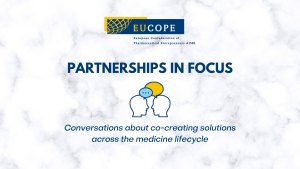News / Partnerships / Partnerships in Focus - June 30, 2022
Partnerships in Focus: Q&A with FIPRA’s Sheela Upadhyaya
At EUCOPE, our commitment is to lead and engage in partnerships spanning the entire medicine lifecycle to find actionable solutions that benefit our members, the patients they serve and healthcare systems overall. Through our Partnerships in Focus series, we’ll be highlighting different associates that we partner with to co-create solutions for various challenges across the healthcare ecosystem.
For this edition, we are speaking with Sheela Upadhyaya, Healthcare Special Advisor, FIPRA International. Sheela has a passion for partnership working and believes that collaboration across the sector is the key to delivering high quality outcomes for all. She currently works with EUCOPE on the Together4RareDiseases and RWE4Decisions projects.
Sheela has worked as an Associate Director of the Highly Specialised Technology programme at the UK National Institute for Health and Care Excellence (NICE) since 2015, responsible for running the programme to evaluate medicines and technologies for rare and ultra-rare conditions for commissioning in the National Health Service (NHS).
Prior to joining NICE, Sheela commissioned rare and ultra-orphan disease services in the NHS, delivering improvements through collaborating with industry, clinicians and patient groups. Sheela sits on the board of the World Orphan Drug Congress, and has participated in several European projects such as ORPH-VAL European Working Group for Value Assessment and Funding Processes in Rare Diseases.
You can watch the full Q&A below on our YouTube channel. The transcript can be found below.
What do you think has caused the recent revolution in orphan drug development?
I think in terms of my experience with orphan diseases and drug development, it’s clear that the legislation has really helped incentivize companies and the healthcare landscape in terms of bringing new therapies into diseases. I think with the advent of genomics, genetic testing and a greater understanding and awareness of rare diseases has enabled people to become more interested and acknowledge and recognize that this is an underserved area. That has helped with the increase, and in some respects, the avalanche of new therapies that are coming out for patients with rare diseases.
What are the biggest challenges for people with rare diseases in accessing treatment?
There are so many challenges for patients with rare diseases in terms of accessing treatment. But I think the first challenge is actually getting a diagnosis. Without a diagnosis, the options and the opportunities to access treatment are really, really difficult. Once you’ve overcome that hurdle and then you understand your condition and have some awareness, then you’ve got an opportunity to understand where treatments are available. The challenge then comes with service provision. So are there services or clinicians available who understand you and can direct you to the right treatment?
Then I think patients and families struggle to be educated and understand what’s available and what’s right for them. And then the final hurdle is healthcare systems enabling access to the services and to the treatments and being able to navigate through a system. I think a lot of patients in rare diseases really find it difficult, particularly in countries where the health care system may be less developed and less clear and understanding how that works. Of course, the other angle is how much these medicines cost. So health care systems struggle to find budgets and therefore that can also be a barrier to access.
The pandemic has unveiled innovative new ways of working and has created unexpected but valuable alliances that we can build on. How can we take these lessons learned to rework the rare disease ecosystem through partnership?
The COVID pandemic, whilst it was the most awful situation that we all, across the world, had come across, it certainly did build a lot of new practices. And I think for me and my experience, it showed that countries, healthcare systems, industry, patient groups and the whole system can mobilize and work together and work more collaboratively for a central objective. And I think that’s where we need to learn from and mobilize in rare diseases.
We have a shared aim in rare diseases, but we don’t work collaboratively together, we don’t share data, we don’t share experience, we don’t share knowledge. I think if we started to be more open and comfortable in sharing that knowledge and being available to understand the constraints of each of those stakeholders, the landscape for rare diseases could change dramatically. And that for me would be a real lesson. Collaborate and share information across different stakeholders so that if we start to understand the landscape better, we start to understand each other’s constraints and we can then find a way through for patients with rare diseases.
95% of rare disease patients do not have treatments today. How can multi-stakeholder collaborations improve equitable access to medicines for everyone?
95% of patients don’t have access to any treatments in rare diseases and this is a really terrible thing from my perspective. Particularly, if you look at the legislation that’s been in place and that was put into incentivize. A lot of the research and the access to therapies is in conditions that have already got treatments. So we’ve got to find a way to incentivize how and where treatments are developed. And I think that the Together4RareDiseases initiative is going to provide a fantastic platform for the European Reference Networks – known as ERNs – and the industry to work together to find ways to understand the rare diseases better to build a good foundation for burden of disease, natural history studies, registries to understand patients that will then help build a better foundation for new therapies to be developed.
But again, those collaborations can be used to understand the next steps in the lifecycle that then translate into how we ensure access is secured. If we understand the disease, then we start to understand all of the elements that go alongside it in order to make that access happen. I return back to what I said earlier – Collaboration, partnership, sharing information and understanding each other’s constraints and compromises to be made within the system for everyone. We’ll start building a much better system for all of us.
What would you say are the benefits of partnering with industry associations like EUCOPE, in order to deliver high-quality outcomes for all stakeholders?
Partnering across the healthcare ecosystem is the most important priority. No stakeholder can build responses to these really big health issues on their own. So we all bring something to the party, so to speak. Industry, with its experience, knowledge and resources, is important because the healthcare systems may be well equipped to do some things, but less equipped to do other things. Only by partnering with industry, can we start to build a much stronger picture and a stronger foundation. I think the benefits of working with trade associations like EUCOPE will be seen by the skill mix and the intelligence and the understanding that they bring from a different perspective into the healthcare landscape that will then improve the access for rare disease therapy.
To learn more about our partnerships or how to join EUCOPE as a member, please contact us at office@eucope.org


